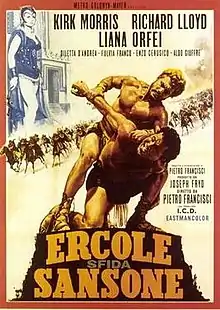Hercules, Samson and Ulysses
Hercules, Samson and Ulysses, (Italian: Ercole sfida Sansone) is a 1963 Italian Metrocolor peplum film directed by Pietro Francisci.[3]
| Hercules, Samson and Ulysses | |
|---|---|
 Italian poster for Hercules, Samson and Ulysses | |
| Directed by | Pietro Francisci |
| Produced by | Joseph Byrd[1] |
| Screenplay by | Pietro Francisci[1] |
| Starring |
|
| Music by | Angelo Francesco Lavagnino[1] |
| Cinematography | Silvano Ippoliti[1] |
| Edited by | Pietro Francisci[2] |
Production company | I.C.D.[1] |
| Distributed by | Metro-Goldwyn-Mayer |
Release date |
|
Running time | 93 minutes[1] |
| Country | Italy[2] |
The costume designers for this movie used re-purposed Nazi helmets for the Philistine headgear.[4][5]
Plot
On one of the many Greek Islands, Hercules and Ulysses are asked to kill a sea serpent menacing the coast and its inhabitants. They succeed, but their ship is caught in a storm. Shipwrecked, they come to Phoenicia and encounter the mighty Samson, who they help in battling the vicious Phoenicians.
Cast
- Kirk Morris: Hercules
- Iloosh Khoshabe: Samson (aka Richard Lloyd)
- Enzo Cerusico: Ulysses
- Liana Orfei: Delilah
- Diletta D'Andrea: Leria
- Fulvia Franco: Ithaca Queen
- Aldo Giuffrè: Seren
- Pietro Tordi: Azer
Film continuity
Hercules, Samson and Ulysses is a sequel to the 1959 film Hercules Unchained and the 1958 film Hercules both starring Steve Reeves, the first actor to portray the mythical hero in a motion picture. Hercules, Samson and Ulysses is the third Hercules film written and directed by Pietro Francisci. Fans may easily recognize several of the supporting cast from the two previous films who served as crew members of the legendary Argo featured in the earlier films. Hercules, Samson and Ulysses also maintains a continuity in its story, including Hercules' married life, and the country Hercules lives in as Ithaca which is ruled by King Laertes. Hercules' closest companion is still Ulysses who continues using carrier birds to send messages back to Ithaca as seen in Hercules Unchained. Ulysses' portrayal is similar to that seen in the Reeves films, including dating a young woman named Penelope who worries about him during his distant adventures.
There are noticeable changes in the main casting. As Steve Reeves' career quickly took off after the success of the first Hercules film that began the sword & sandal film craze of the early and mid 1960s, Reeves was unavailable to return to the role of Hercules with his obligation to the film Sandokan the Great in 1963. Italian bodybuilder Kirk Morris was cast in the role of Hercules. The faithful sidekick of Hercules featured Italian actor Enzo Cerusico as opposed to Gabriele Antonini who played the supporting role of Ulysses in both Reeves films. Italian actor Andrea Fantasia maintained his role as King Laertes of Ithaca from the Reeves films. Actress/model Sylva Koscina was unavailable in 1963, and the role of Hercules' wife Iole, was portrayed by actress Diletta D'Andrea. The third film also suggests a time lapse in which Hercules and Iole have a young boy.
Crossover
The film sets Hercules' adventure in Judea, a land largely referred to in biblical accounts. There are vague biblical references including the film's second strongman Samson also referred to as Samson, the Danite, an enemy and fugitive of the Phillistines. The film's subplot centers around the established fact that the fugitive Samson possesses god-given strength to kill wild animals–specifically lions with his bare hands. When Hercules arrives in Judea and displays similar strength to slay a lion with his bare hands, he is mistaken by the Phillistine king Seren for Samson as he heard prophecy foretell his death by Samson's hands.
The film also features a femme fatale named Delilah, mistress of the Phillistine king Seren. The film selectively chooses elements from the biblical account of Delilah and portrays her as a cunning seductress who first meets and persuades Hercules to capture Samson in exchange for the lives of his friends held prisoner by King Seren. After her plan fails she is shown mercy by Samson, who is charmed by her beauty and agrees to let her return to King Seren. Hercules realizes Samson has fallen in love with Delilah and cautions him against her skillful deception. Delilah reneges on her promise to help Hercules and Samson escape the Phillistines. She betrays the two heroes and sets a trap with the Phillistine king. Hercules and Samson overcome the trap laid for them and the king is killed in battle by Samson. Towards the film's end there is a vague reference made to the biblical account of Samson and Delilah when Hercules warns Samson once more to beware of any further deception by Delilah.
Release
Hercules, Samson and Ulysses opened on December 20, 1963 in Italy. It was released in May 1965 in the United States.[1]
References
- Kinnard, Roy; Crnkovich, Tony (28 February 2017). Italian Sword and Sandal Films, 1908-1990. McFarland. pp. 91–92. ISBN 978-1476627045.
- Brennan, Sandra. "Ercole Sfida Sansone". Allmovie. Retrieved 5 April 2014.
- Chiti, Roberto; Roberto Poppi; Enrico Lancia; Mario Pecorari (1992). Dizionario del cinema italiano. I film [Dictionary of Italian cinema: films] (in Italian). 6 (1 ed.). Gremese Editore. p. 189. ISBN 978-8884401373.
- "Doctor K's Cult Classica: Hercules, Samson and Ulysses". The Bureau Chiefs. 14 May 2010. Retrieved 24 October 2019.
- "Hercules, Samson & Ulysses (1963): Goofs". IMDb.
External links
- Hercules, Samson and Ulysses at IMDb
- Hercules, Samson and Ulysses at AllMovie
- Hercules, Samson and Ulysses at the TCM Movie Database